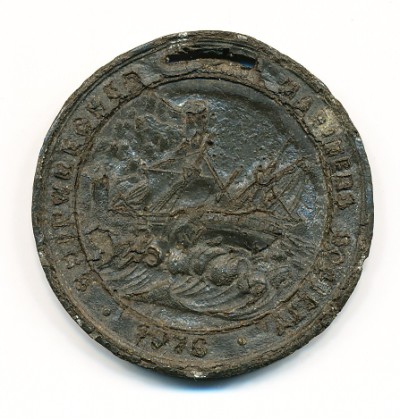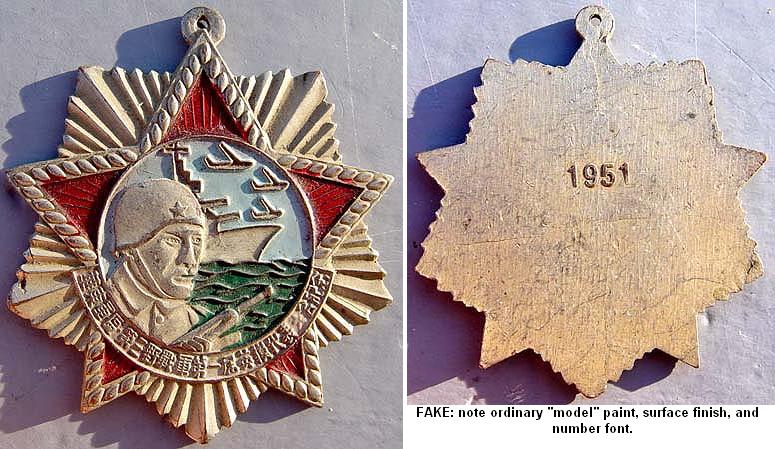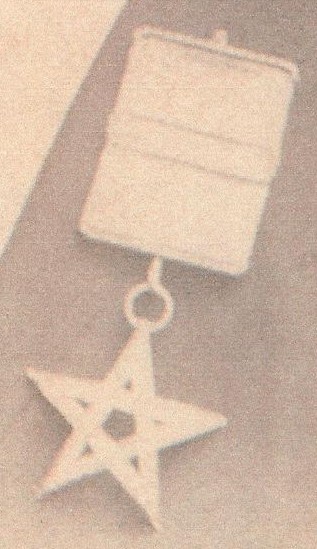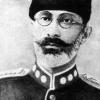-
Posts
4,254 -
Joined
-
Last visited
-
Days Won
11
Content Type
Profiles
Forums
Blogs
Gallery
Events
Store
Posts posted by paul wood
-
-
from turkey my freind baris has bought this medal bar.so called as nick name deermaster-bran.I think he also sold to another collector.very rare item.minature with sword mecid I have never seen.
akin
I am not at all surprised at the price it made and a suspect the eventual purchaser will be delighted. I have never seen a miniature Medjidie with scimitars (considering they were only issued from 1915 in full-size they must be incredibly rare as miniatures, especially to a Turkish recipient and GENUINE scimitars on the full-sized are scarce to say the least (beware of copies)).
All the best,
Paul
0 -
Full list to come. Clasp? OK, the scan is fuzzy. "Overseas Korea 1950-53".

If on the market it would certainly drain the rupee account.
Paul
0 -
Good guess Paul. Though it was my understanding that, in Iraq, the National Assembly was rather quickly dispensed with after they passed, in 1931, law No. 1 (of 1) regarding the reunification of 'Kuwait' with Iraq. All that messy 'democracy', you know . . . .
But I still like your theory.
Until someone looks into the records -- which either probably no longer exist (in Iraq) or simply won't be shared (Garrard's) -- we'll never know.
Other possibility is that they could be judges badges. I have seen similar things for Egypt.
Paul
0 -
I bought this possible Specimen of rejected design for the Royal Order of Two Rivers. From an antique dealer in Baghdad, Iraq. I am still trying to understand what it is, just a mistery piece in my collection of Iraqi ODM.
Manufactured By: Garrard Jewlery Co.
Thank You
God Bless
SSG Luna, Lorenzo
Just a thought, although those idle B****rs at Garrards could confirm. Could they be something like a badge for a member of the National Assembly the quality of stars denoting rank, I know some middle eastern countries had those sort of things in the pre-war years.
Paul
0 -
2
Not Russian but Serbian. Its the 1876 Medal for Bravery for the catastrophic war against the Ottoman Empire in 1876, the obverse reads For Bravery 1876; the reverse Milan M. Obrenovich IV Prince of Serbia.
Hope this helps,
Paul
0 -
Going to cash them in?

Very interesting contemporary military archive.
Paul
0 -
There is a good write up on him in German Wikpedia.
Paul
0 -
Hope to have this in a few days so this is just a teaser, any reason for just two medals, POW, wounded.....welcome your thoughts. Paul
Surely if wounded he would have been entitled to a wound badge.
Paul
0 -
It has surely had a very hard life!

So have I but I don't look that rough.
Paul
0 -
Thanks for the help with this one.....I'll post a close-up of the reverse.
Kr.....Peter

From the photo it appears that the recipient became a member in 1870, up until 1882 the reverse were dated with year of enrollment.
All the best,
Paul
1 -
It doesn't appear to be either the Davidson's (which was issued to all ranks) or the Boulton's - the descriptions of the busts are wrong. Both of those are rare and valuable. One story is that once the tars realized the Davidson's weren't precious metal - an hence not saleable- they either threw them overside or nailed them to the mast of whatever ship they were serving on, even prying them off again when transferred to another vessel.
Probably a privately produced souvenir piece, but if the condition is any indicator possibly contemporary to the event and therefore of some interest.
Peter
It's the medal of the Shipwrecked Fishermen and Mariners Benevolent Society, 1855 pattern and was a membership badge, the medal was designed by J. Davis of Birmingham. It is the scarcer of the two major varieties of the medal.
Paul
0 -
The point of these is that it is part of the Chinese cottage industry that is producing fakes from Imperial to modern times in huge quantities, they cost vitually nothing to produce and if some sucker will pay $10 on E-bay they have made a good mark up. With Chinese and related material avoid E-Bay like the bubonic plague unless you really know what you are doing.
Thats my yuan's worth,
Paul
I am BAFFLED as to the point of all of these. There is ZERO collector interest-- and unfortunately there never will be any, since the tidal wave of fakes and fantasy pieces completely overwhelms the token few real Civil and Korean War period PRC awrads that are out here.
Again, I do not have an original to compare this with, but obviously from the same source as the above, newly sculpted rather than cast from an original, and completely wrong materials and finish:

The collecting well is so thoroughly poisoned by fakes that it is just plain aamzing who is wholesaling these from wherever they come from to where we see them... everywhere.

 0
0 -
The top one (Romanov) is worn from a black-orange-white striped ribbon.

Don't know the other one.
/Mike
The other is an unofficial Tolstoy commemorative in white metal, I suspect it would be very difficut to trace the original riband.
Paul
0 -
Most interesting. I have encountered many coins, usually the host coins of where the serviceman was based, used as ID tags. I recently encountered a French 2 Franc coin with the reverse erased and used as an ID tag for a member of the tank corps with a beautiful engraving of a tank in the centre.
0 -
He is still Grand Master of the Orden vom Goldenen Vlies and still can bestow it as it is a dynastic order rather than a national order. Nice to know he is still allive and kicking must have his mother's, Zita's, blood has she was well in he 90s when she died.
Paul
0 -
Hello Gents,
I was sent a picture of an American in civil clothing wearing the medal in the picture below ... the wearer was born in 1850 and it's assumed the picture dates from 1875-1880 or thereabouts. He lived in Mississippi throughout his life.
Any information on this medal would be helpful !

Thanks & regards,
Hendrik
Hendrik,
Given that he is a civilian it would appear that the medal is of the nature of a masonic jewel. Several masonic jewels have used the Star of David (or King Solomon's seal) as all or part of their imagery. Unfotunately the detail is to fuzzy to give it a more precise identification.
All the best,
Paul
0 -
Can anyone provide information on the following man and his two medals IGSM Bars WAZIRISTAN 1919-21, WAZIRISTAN 1921-24 2749 NK.DASONDA SINGH,36 SIKHS, LSGC, 3005 NK.DASONDHA SINGH,4-11 SIKH R. Is it strange that a man with LSGC for 20 years service has only two medals!!
I have never researched Indian recipients and to be honest these are the only two I have in my collection, hope someone out there in this global metropolis can help

Photo of medals attached

Best regards
Geoff.
Dear Geoff,
What a nice pair of medals the 36th sikhs were raised in 1887 and disbanded in then great axe of 1922 and were merged in to the 11th Sikhs. He would have received his LGSC prior to 1930 when they changed the design of the medal so he would have joined prior to 1910. The regiment was not involved in NW Frontier 1908 campaign nor the Abor Campaign of 1911-12. He may well have been based in India or non-combattive zone in WW1 which means (unlike British troops he would not have received a British War Medal). It is very likely that the pair is his sole entitlement.
Unfortunatley being an NCO it is nigh impossible to do any detailed research, especially as it is quite likely the regimental records may well be in Pakistan, which is inaccessible. Where he a Jemadar of a Subadar (native commissioned ranks) then it would be possible to obtain his war services.
Still I think you ought to be pleased to own such a nice pair to a soldier who gave exemplary service to the King Emperor over many years.
All the best,
Paul
0 -
Hi all
Precious little information on the composition of the medallion held between the glass and rim. Generally they are assumed to be gold-plated base metal (so intrinsically worth virtually nothing as scrap metal) and are incredibly common amongst Masonic jewels. I have seen hundreds (honestly, no exaggeration!) of these and perhaps just one percent of those have carried hallmarks.
The hallmarks were on the reverse face and situated either side of the square and compass, quite apparent without having to dismantle the item. Anecdotally, I have heard of hallmarks on the rim of the medallion itself, but have not seen this for myself. All hallmarked medallions I have seen so far have been silver-gilt (i.e. gold electroplated coating onto solid sterling silver medallion), never seen or heard of a solid gold version. Depending on the testing method, or preparation for such, might give a false-positive result if testing the gold-plate, rather than any metal underneath.
You can find these regularly on eBay where they fetch less than ?10 (US$20). In a more cynical frame of mind, I guess that if these (medallions) were solid gold, then they might sell for more than that just for their scrap value!
Hope that helps,
Richard
For anyone interested in Masonic medals and Jewels and related medals and tokens (British and empire) there is a new and very good book by Trever I Harris, The Medals and Jewels of British Freemasonary, London 2007, IBSN 978-0-9554447-0-8. This book has been produced in collaboration with the Library and Museum of the Freemason's Hall and is lavishly illustrated and gives details of the various varieties of the awards etc. There are 8 distinct varieties of the Sussex jewel which was established in 1830 and is still going. including the one with the hallmarked gold ring. The earlier ones are of superior quality (I am thinking of the ones which turn up with the effects of Crimean War officer). Certainly this book answers if not all most of the questions about masonic medals and as far as I am aware it is the first comprehensive work on the subject.
Hope this is of interest,
Paul
0 -
There are many coins commemorating military history. One of the earliest ones that I can think of is the Hanoverian thaler for the 50th Anniversary of Waterloo in 1865. Prussia in 1871 produced the siegesthaler to commemorate the victory over the French in the Franco Prussian War. In 1913 they along with Saxony produced a 3 mark coin to commemorate the centenary of the Battle of Leipzig. Russia issued a commemorative rouble for the bicentenary of the battle of Gangut in 1914 (in 1839 they produced a rouble and a 11/2 roubles for the building of a memorial for the battle of Borodino). More recently Great Britain produced a 50 pence for the 60th anniversery of D-Day and in 2006 a 50 pence for the 150th anniveraryof the Victoria cross. If you want to go back to antiquity there are many Roman coins commemorating their various military triumphs. One of the most famous being the Judaea Capta srious which commemorates the defeat of the first Jewish revolt in AD 70. So certainly there is a wealth of numismatic material related to military events and I suspect quirte a large collection could be formed of such material.
All the best,
Paul
0 -
Serbian Orders were made by a variety of manufacturers, mostly Austrian, Karl Fischmeister being the main maker for Obrenovich Orders. I suspect your piece is not made by one of the regular manufacturers and certainly it would have had the enamelled Serb Arms on the reverse. It does appear to be silver,which is most unusual as the Officer's badge of the Takovo was silver gilt and enamelled, it can't be a Knight's badge as they were just gilt metal. It appears what you have is an interesting variation. Possibly even privately made to make up either for a lost piece or for a piece which did not arrive from Serbia, posibly due to the defenestration of Belgrade
Thats my paras worth,
All the best,
Paul
0 -
From 1856 to 1913 205336 St George crosses 4th class were awarded. In 1913 they started renumbering the crosses from 1, engraving"N?" in front of the number to distinguish them from the older ones. the problem is that this was only possible for the crosses up to n?99999, since there is not enough room on the cross arms to put 3 numbers + "N?".
So it is hard to distinguish the old crosses from the new ones for the number range of 100000 to 205336. So it is possible that this is actually a preWWI St George cross, maybe even awarded for the Russo-Japanese war. Logically the price for such a cross would be much higher than for a WWI cross.
Jan
It's a 1905 issue, in Lavrouk's auction 44 in Moscow (June 2007) they had one numbered 115240 which was estimated at $3000. Russo-Jap war issues are considerably more sought after than Great War issues and earlier ones from the 1860's and 70's would make even more.
Hope this helps,
Paul
0 -
Hi, thanks for everyones help on this one. I now have both London Gazette entries will the full list of names. I have this in alphabetical order as well if anyone wants a look up. Mark.
Appendix 8 and 9 in Spink's British Battles and Medals has a list of all British recipients of all foreign (ie non British ) awards in the Crimea war (including grade). If you haven't got one yet and are even vaguely interested in British Campaign medals you ought to get one.
Paul
0 -
Hello Kevin, hello Uwe,
thanks for your help...

@Uwe: great work ! yes i think this will be right ...
I have never seen this Award before.
Thanks for your helps (so i will post this answer at forum-der-wehrmacht)
sunny greetings from Unna
und Uwe ein Krombacher extra ;-)
Uwe,
I accept that by porpulation it is likely to be Bern but could it not be St Gallen or even Appenzel both of which have bears on their arms (although due to viele Schutzfesten (some unofficial) the poor old bears are pretty well extinct in the wilds of Switzerland).
Paul
0 -
Someone (FJP?) had one for sale recently.
There was a nice illustration that I cannot locate now.
The Cross of Valour (that is the Amin Dada VC). Is Identical to the Victoria Cross the exception being instead of a Lion good old Idi's mugshot and the motto FOR GOD AND MY COUNTRY, the reverse has the Ugandan arms motto FOR SUPREME VALOUR. Does nobody own a copy of Werlich? both sides are illustrated. I can understand the Scottish nurse not wanting to treat him as he had a particularly virrulent form of the disease of Venus.
All the best,
Paul
0




Zanzibar: Orders, Decorations and Medals
in Middle East & Arab States
Posted
I have a draft of Gustav Tamman's work on the Orders and Dcorations of the Sultanate of Zanzibar. I think the original draft was about 12 years ago but it is still very useful epecially for the toughra types and the comparative rarity of issues. It would be nice if a completed work was eventually published but knownig Gustav as I do he will always keep finding extra information thus putting the publication date ever forward.
Paul